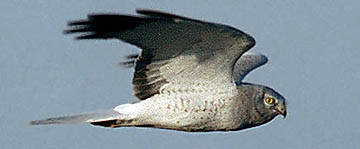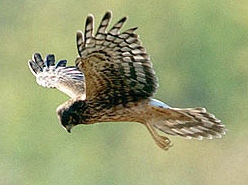|

Large hawk with gray upperparts, distinct white rump,
and white underparts with spotted breast. Hooked bill is dark, yellow
at base. Eyes are yellow. Wings are long, gray above, and white below
with black tips. Legs, feet are yellow. Alternates several deep wing
beats with glides.


|
NORTHERN
HARRIER
Circus cyaneus
FALCONIFORMES
Kites, Eagles and Hawks (Accipitridae)
Range and Habitat
Breeds from Alaska to the northern U.S. Spends winters from the southern
U.S. to Central America. Preferred habitats include open fields, savannas,
meadows, and marshes.
SOUND: "kek, kek, kek", "keee, keee, keee"

Unusual among hawks, Northern Harriers use their sense of hearing to
help locate prey. They have an owl-like facial disk to help with directional
hearing and soft feathers for a quieter flight.
Their species name, Circus cyanus, comes from the Greek word “kirkos”,
meaning circle and the word “cyan” which is a shade of blue.
These refer to the Northern Harrier’s flight pattern while hunting
and the color of the male bird.
The common name, Harrier, is from the Old English word “herigan”
and means to harass or plunder.
A group of harriers has many collective nouns, including a "swarm"
and a "harassment" of harriers.
The Northern Harrier has a large range, estimated globally at 1,000,000
to 10,000,000 kilometers. Native to Europe, Asia,
and the Americas and introduced to parts of
Africa and Bermuda, this bird prefers grassland,
wetland, forest, and shrubland ecosystems.

|